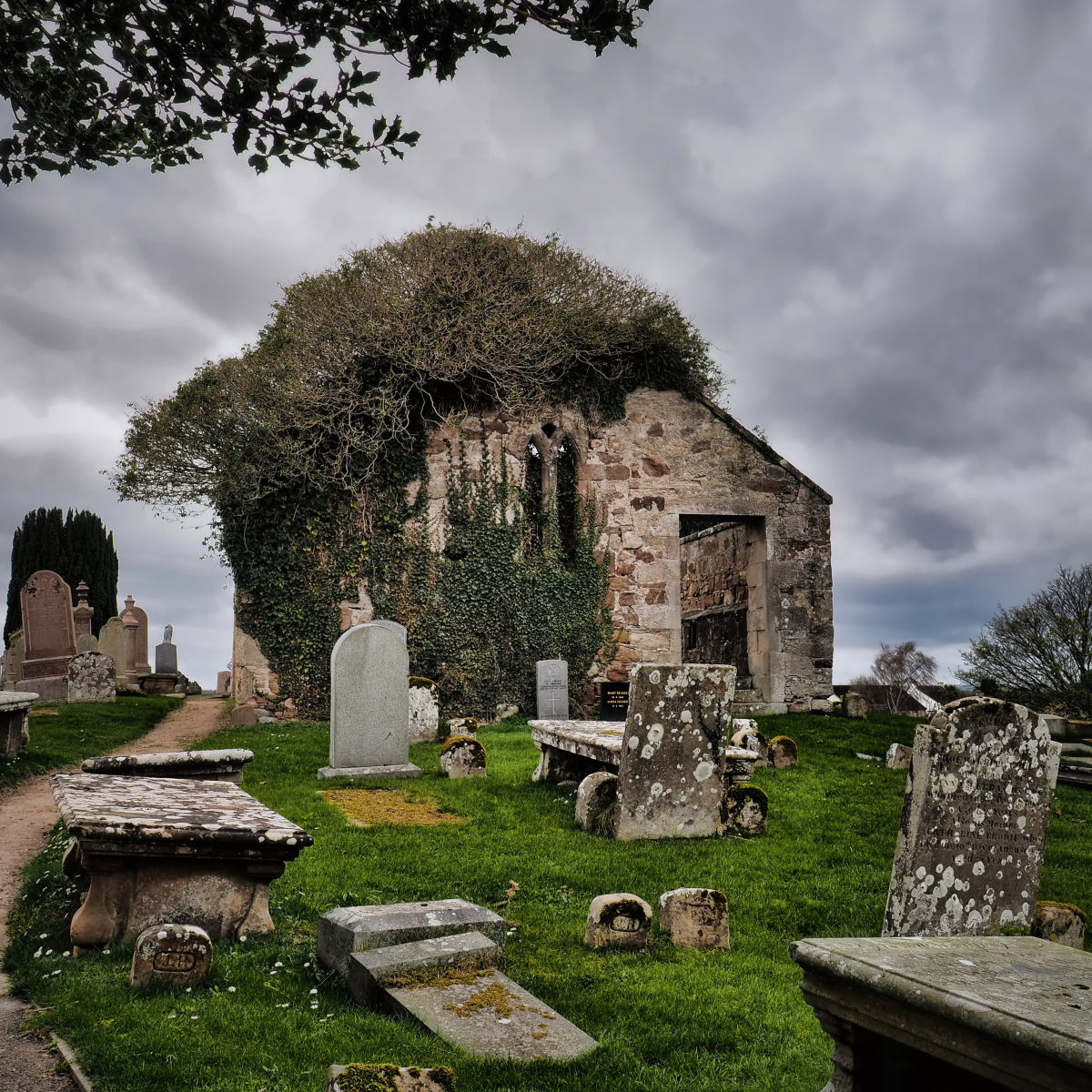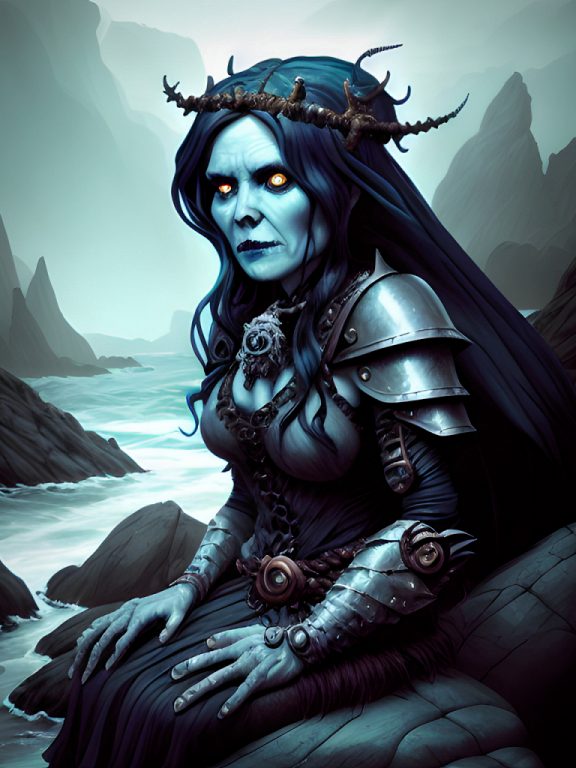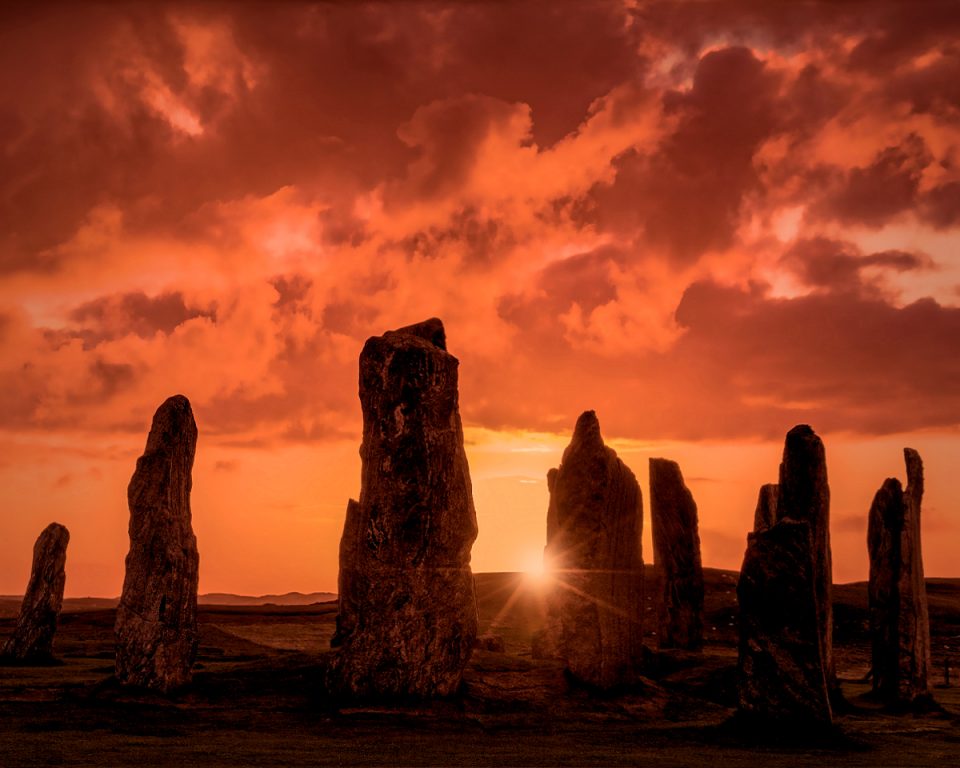Isobel Gowdie was a difficult assignment for us. Spooky Scotland has taken us to many haunted destinations. However, it seems that we pass through Auldearn on a regular occurrence to get to many other spooky sites: Cawdor Castle, Rait Castle, the Clava Cairns and Culloden Moor to name a few. On the surface, Auldearn appears to be a sleepy Highland village, the kind of place you might think would pass through the history books, unrecognised. However, the 1600s were turbulent times for Auldearn. The village took its place in the annals of Scotland’s dark history in 1645 with the ‘Battle of Auldearn’ where over 2,000 Covenanters were slain. Then, in 1662, it became the scene of one of the most bizarre witch hunts in Scotland. The witchcraft confessions by Isobel Gowdie are some of the most extraordinary on record. She is possibly the most famous ‘witch’ in Scottish history. This is the woman who gave the world the notion of a coven. Some say that her ghost still haunts Auldearn. Sifting through the information on Isobel Gowdie was difficult: there is far more myth and fantasy surrounding the poor woman than there is fact.
Isobel Gowdie and the Arts
Isobel Gowdie has achieved modern notoriety, as she has been the subject of several modern works. These include:
• The Confession of Isobel Gowdie (1990), an acclaimed orchestral piece by James Macmillan.
• The Devil’s Mistress (1915), a novel by John Brodie-Innes.
• The Drowning Pond (2005), a novel by Catherine Forde.
• Isobel (1977), a novel by Jane Parkhurst
• Night Plague (1994), a novel by Graham Masterton
• The Witch of Auldearn (2007), a play by John Lawson
• Isobel Goudie (1972), a song by the Sensational Alex Harvey Band from their Album ‘Frame’.
She is also one of the few historical witches to appear in the Oxford Dictionary of National Biography and she featured prominently in ‘The Witch-Cult in Western Europe’ by Margaret Murray, a book which was to have a significant influence on the emerging new religious movement of Wicca in the 1920s.
With so many popular works, sometimes the lines between fact and fiction merge, making it hard to find out who Isobel Gowdie really was.
Debunking the Fiction about Isobel Gowdie
A lot of the so-called ‘fact’ about Isobel Gowdie has stemmed from the John Brodie-Innes’ novel. According to Brodie-Innes, she was young, attractive and red-headed, her father was a lawyer, her husband was a Kirk Elder and she married beneath her station. We simply do not know if any of these things are true. We do know that Isobel Gowdie was a real person who was tried for witchcraft and we do have her confessions. In the process of writing this piece, I have chosen to use the academic work, ‘The Visions of Isobel Gowdie’ by Emma Wilby as my main source of information.
The Real Isobel Gowdie
Very little is known about Isobel Gowdie. She was married to John Gilbert, who had no involvement with the witchcraft case. It seems likely that she was brought up in the Auldearn area as she extensively mentions many of the nearby villages, hamlets and ‘ferm touns’ during her confession. We do not know what her age was, but as the legal age for marriage in Scotland at the time was fifteen years old, we can assume she had to be older than this. It should be noted that the average age for getting married in Scotland during this time period was twenty-six or twenty-seven. In addition, during her confession she alluded to have engaged in sexual practices some fifteen years earlier, placing her somewhere between thirty to fifty years of age. We do not know if she had any children. There are no surviving records from the time and she made no reference to children in any of her confessions.
Isobel Gowdie and her husband lived in Loch Loy, some two miles north of Auldearn. It seems likely that Isobel’s husband was a farm labourer, perhaps a cottar hired by one of the tenant farmers of the Laird of Park and Loch Loy, one John Hay whose ancestor Sir William Hay, is interred at Elgin Cathedral. As a cottar he would have been provided with a cottage and a parcel of land. Isobel claims to have helped her husband sell ‘beeff’ and webs of cloth for ‘silver and good pryce’ at the local market.
It is likely that she lived her life in a turf house and spent her days milking, baking bread, weeding and perhaps spinning yarn. Records indicate that the Laird of Park’s tenants grew flax for linen production. It seems probable that Isobel Gowdie had little or no education. However, despite being unable to read or write, Isobel possessed a good imagination and could express herself eloquently. Perhaps the thing which sets Isobel apart from other witch trials of the time is the sheer volume of her confession.
The Confessions of Isobel Gowdie
The outcome of Isobel Gowdie’s confessions are unknown and she slipped into obscurity for nearly two hundred years until her confessions were published in 1833 in Robert Pitcairn’s ‘Ancient Criminal Trials in Scotland’. Although the confessions quickly became celebrated, the original documents went missing. They were only rediscovered two centuries later when they were found in an uncatalogued box of papers once belonging to Isobel’s landlord, the Laird of Park, in the National Archives of Scotland.
The papers reveal that Isobel Gowdie made a series of four confessions over a six-week period, the first being 13th April 1662 in Auldearn, Nairnshire. In keeping with the time, Isobel would have been keep in solitary confinement, probably in the Tolbooth in Auldearn where she was likely beaten and deprived of sleep. Meanwhile, her co-accused, Janet Breadhead, was held in Inshoch Castle, the seat of the Laird of Park.
During the course of her imprisonment, she was interrogated by the local ministers, Harry Forbes and Hugh Rose in the presence of at least a dozen witnesses, including a public notary John Innes. Her testimony bears the heavy imprint of a prosecutorial mind. Anxious to convict, the prosecutors clearly had preconceptions about the crimes witches supposedly committed and her confession was clearly lead with, “When did you make a pact with the Devil?” and, “When did you fly to the Witches’ Sabbath?” type questions.
Isobel Gowdie and a Coerced Confession
Isobel Gowdie’s first confession begins with the assertion that “the said Isobell Gowdie appearing penitent for hir haynows (heinous) sines of witch craft and th[a]t she haid bein ower long in th[a]t service w[i]thout any compulsitoris proceidit in hir confessione” and concludes that it was “spokin and willinglie confest”.
This does not mean that Isobel was not tortured by modern day standards but likely escaped the horrors of judicial torture or illegal physical torture using a torture device. It seems probable that she was subjected to the horrors of sleep deprivation. She may have endured the indignity of a facing a witch pricker, one which was known to be active in Moray at the time who went by the name of John Dickson. It turned out that Mr Dickson was really a woman named Christian Caddell, who was deported to Barbados in 1663 for her fraudulent behaviour.
It seems alien to the modern mind that anybody would stand up in court and confess to entering a pact with the Devil, or to having performed a ritual or charm which caused the death of a child, knowing that it would be signing their death warrant. Yet many did.
Isobel Gowdie Tortured
There is little doubt that many witchcraft suspects were coerced into making a full confession. However, there were many different forms of torture as seen below:
1. Judicial torture: the application of physical coercion as part of the legal process in order to extract a confession. This may have included the use of thumb screws and the iron boot. Permission had to be granted from the Privy Council for this form of torture to be used. Most witchcraft cases originated in church courts. Church courts were never legally allowed to use direct torture to obtain a confession. However, there is evidence torture devices were used illegally.
2. Searches for a witch-mark or witch-pricking. This was considered to be legal, and there were people employed as witch-prickers. The pricker tested for the devil’s mark, a spot on the body where a pin could be slipped in without bleeding or pain. This was seen as proof that the witch had entered into a pact with the Devil, getting powers to cause maleficium. The pricker began by stripping the victim naked and shaved them from head to toe. Then the pin was pushed in, again and again, until the right spot was found. This was not a small dressmaker’s pin, but a thicker hand-made pin, several inches long. Sometimes the victim would pass out during the experience and be incapable of calling out in pain. In other cases, parts of the body were massaged until numb. Sometimes the witch pricker would use a retractable blade so it looked like the pin had entered the accused’s flesh, when in reality, the blade had been withdrawn into the handle shaft. However, it should be remembered that this was a society which prized modesty. Most of the victims accused were women who were stripped naked in public and handled all over their bodies. This was humiliating sexual abuse. Many would confess just to make it stop. The witch-pricker, Christian Caddell was active in the area at this time.
3. Sleep deprivation which had the accused held in isolation and watched by guards. This was not considered to be torture during this period and was probably the means by which most of those accused of witchcraft were found guilty. One of the most pronounced effects of sleep deprivation is that it causes hallucinations.
4. Harsh jail conditions including lack of food and warmth and ill treatment including beatings by the guards.
5. Mob violence
6. The threat of a cruel execution.
The Content of Isobel Gowdie’s Confession
Worn down by the pressures of interrogation and hoping for leniency, the poor woman is likely to have told them what they wanted to hear. Recent psychological studies into the phenomenon of false confession show that people can develop false memories. Fatigue and sleep deprivation impair decision making and increase suggestibility. Simply changing the way a question is asked can succeed in influencing a person’s memory of an actual event. Memories may become implanted and the suspect may begin to believe the confession him or herself. Extended sleep deprivation can lead to hallucinations, at which point the interrogators would take this as evidence that the accused was in league with the Devil. It is likely that Isobel may have developed false memories of having performed some of the crimes alleged against her. Consequently, Isobel’s confessions contain many of the standard witch-confession epitomes of the time such as claiming to have made a pact with the Devil, performing harmful magic or maleficium and attending the Witches’ Sabbath. These aspects of her confession are likely to have been derived from leading questions by the prosecution.
Maleficium:
However, parts of Isobel’s confession are so unique, vivid and personalised, that they could have only come from Isobel herself, while some of her confession is rich in folkloric detail. For example, her descriptions are dominated by maleficium, or the use of malicious magic, following many of the standard rituals found in other witch trials. She attempted to destroy her neighbour, Breadley’s crops by taking a child’s body from the grave and using it as part of an incantation. However, her account of spoiling crops using a puddock (frog) plow so that afterwards, only thistles and briars would grow, is unique. Like many other witches, Isobel claimed to have performed image magic where she used effigies of the Laird of Park’s male offspring to cause them death or suffering. Where she differed from other trials, is in the extensive detail of how she kneaded the clay for the figure “very hard like rye meal” and then gave it “all the marks and parts of a child such as head, eyes, nose, hands, foot, mouth and little lips” and that “the hands of it folded down by its side like a scone or sucking pig.” The effigies were then burnt as a chant was recited.
Maleficium was also directed at the Minister of Auldearn, Harry Forbes, with spells being invoked to inflict illness and torment on the man. Harry Forbes, it seems was a religious zealot with a fear of witchcraft. Shortly after his arrival in Auldearn in 1655, he had confided in Alexander Brodie , the main landholder in the area, that he had been the victim of witchcraft. A surge in awareness of witchcraft as recorded in the diaries of Brodie of Brodie throughout the area seems to coincide with his arrival and then seems to have dissipated after his departure in 1663. Harry Forbes was present at all of Isobel Gowdie’s confessions and it seems all too probable that he was one of the key players in having Isobel indicted.
Isobel also claimed to have transformed herself into a jackdaw and, along with other members of her coven who had transformed themselves into cats and hares, visited Alexander Cumming’s dye works where they used knot magic to turn his dye black.
Demonology:
Much of what Isobel says with regard to demonology is fairly stereotypical. Her claim to have attended the witches’ sabbath is conventional but less conventional is her claim that while the members of her coven were waited on by spirits clothed in yellow and grassgreen who had peculiar nicknames like “pickle nearest the wind”, “Thomas the fairy”and “over the dyke with it”.
During her first confession she gave an account of her first encounter with the Devil. She arranged to meet him in the kirk at Auldearn at night. Naming some others who were in attendance, including Janet Breadhead and Margret Brodie, she said that she renounced her baptism and was re-baptised by the Devil who promptly renamed her Janet. Where she differs from the confession of others is in detailing how the Devil put his mark on her shoulder then sucked her blood. Having admitted to entering into a pact with the Devil, she then disclosed that she had carnal relations with him, kissed his behind and that she met with him in groups as well as on her own. This is standard fare in a witch trial. Where she differs is in the salacious details of her encounters with the Devil, whom she described as being a very cold ‘meikle, blak, roch man’. Allegedly he had forked and cloven feet which he sometimes covered with boots or shoes.
Fairy Lore:
Perhaps even more remarkable are Isobel’s depictions of fairy-related activities. She claimed that she feasted under the local fairy hill, the Downie Hill, the site of an Iron Age fort, with the fairy king and queen, the king being a “brawman well-favoured and broad-faced” and the queen “brawly clothed in white linens”. She also expressed her fear of the ‘water bulls’ which she encountered there.
Isobel claimed that, transformed into the likeness of a crow, she sneaked into the cellars and kitchens of local castles and houses to eat their food, steal ale from barrels and perform magical rituals. She claimed that she had traveled to the “elves’ house” where she saw “hollow and boss-backed” elf-boys whittling elf-arrow heads and, perhaps more bizarrely of all, that she and her companions charmed corn straws and “windlestraws” into horses and then, crying “Horse and Hattock in the Devil’s name!” flew through the air shooting elf-arrows at passers-by. As they had no bows, the arrows were fired using a flick on the thumb. Isobel claimed that her coven had killed with these arrows, as death was inevitable if struck by one of them.
Beneficial Magic:
Throughout her dramatic testimony, Isobel recounts no less then twenty-seven charms, the majority of which are unique in British folklore. She chronicles instances of sickness transferal, where an individual is cured by diverting their illness onto someone or something else. Isobel describes a ritual whereby a sickness is diverted from a bewitched child onto its cradle belt and finally onto a cat or a dog. Some have suggested that Isobel Gowdie may have been a magical practitioner, with her claims to have performed charms and rituals to cure fevers and broken bones, signifying that she functioned as some kind of ‘wise woman’ who, in the absence of doctors, saw to the medical needs of the poor.
Author Emma Wilby suggests that when we compare Isobel Gowdie’s claim to have flown through the air on a corn stalk, to the experiences of shamanic practitioners from Siberia, Scandinavia and the Americas, it is conceivable that that Isobel may have performed some of her magical rites through the medium of dream or trance, in a manner that can be loosely termed as ‘shamanic’. Could it be that Isobel’s more fantastic claims were memories of shamanic acts, undertaken prior to arrest, that were retrieved during interrogation and mingled with folkloric belief, demonological stereotype and real-life experience to form the complex picture that became her testimony?
The Aftermath of Isobel Gowdie’s Confession
After at least six gruelling weeks of incarceration and interrogation, the panel of interrogators felt that they had secured enough evidence to secure a conviction against Isobel Gowdie. They applied to the Privy Council in Edinburgh, seeking a Commission of Justiciary for a local trial to be held. Isobel’s confessions as well as those of Janet Breadhead were sent with the request. According to Wilby, it is probable that the confessions arrived in Edinburgh during the middle of June 1662. The Register for the Privy Council for July contains an entry instructing the Sherriff of Nairn, Sir Hew Campbell of Calder [Cawdor] to arrange local trials for both women.
There is no record of Isobel being executed although this is not unusual: in ninety per cent of Scottish witch trials the outcome is unknown as the records no longer exist. It seems likely that Isobel Gowdie and Janet Breadhead would have been found guilty at a local trial held in mid-July. Following the verdict, they would have been transported by cart to Gallowhill, on the outskirts of Nairn, where they would have been strangled and burnt. The burning of the deceased body was to ensure that no postmortem sorcery could occur. The execution would have been a public affair, with the whole community forced to attend.
During the course of her confession, Isobel Gowdie implicated another twelve people as witches, the members of her coven. Janet Breadhead implicated three times as many people as Isobel. What happened to these wretches, we will never know. We do know that Isobel’s husband was not involved, with Isobel declaring that she left a broom in the bed beside him while out on the Devil’s errand so he would think she was still in bed. Was this a deliberate tactic to take the scent away from her husband?
Many reasons have been given to explain the bizarre nature of Isobel Gowdie’s confession. Some have assumed that she must have had some form of psychosis. Others have suggested that she was suffering from ergotism. Ergot is a mould that grows only on rye and can cause hallucinations if ingested. Rye has never been grown in any quantity in Scotland and can generally be discredited in most Scottish witch trials. However, rye was grown in Nairn at the time Isobel was alive. There are pollen records to prove it and Isobel mentions rye in her confession.
Isobel Gowdie has passed into both legend and history books and yet there are some who say that she is the ‘Green Lady’ who still haunts the area around Auldearn to this day.




